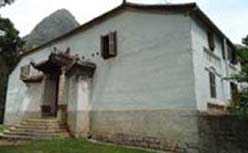On a tour of Ha Giang Province we visited Dong Van Plateau and decided to take a day to see the palace where the king of the Hmong people lived early last century.
 |
|
The palace of Vua Meo, where the king of H’Mong lived last century in Dong Van Plateau, Ha Giang Province |
Often dubbed Vua Meo (king of H’mong), the palace’s official name is Vuong Chinh Sinh. The Hmong king ruled over a vast territory from Dong Van Plateau to Meo Vac Town.
During his reign, the charismatic king attracted a lot of attention when he and other Meo residents joined forces with Ho Chi Minh to gain national freedom.
The palace is in Sa Phin valley in Lung Phin Commune, Dong Van District at the base of a mountain, backed by cliffs and topped by a mass of clouds.
Tall sa moc trees surround the palace that is built from stone, fir wood and terra-cotta tiles in the Chinese architectural style of the Man Qing era.
Our first impression was of a small market called Sa Phin market at the palace gates and a parking lot run by H’Mong people, many of whom are descendents of Vua Meo.
 |
| The king of the Hmong lived in this palace in the early 20th Century |
Covering a total area of 1,120 square meters, the palace was used as a residence and fortress during the Vuong Dynasty.
The two storey, 50 meter long palace that took eight years to build has four long houses and six wide houses with 64 rooms for the king’s wives, children and soldiers.
All the walls are 50-60 centimeters thick. Surrounding it is stone barrier which is 2 meters high and 80 centimeters thick.
The palace is divided into many areas such as dining room, bed room, kitchen, marijuana store, rooms of his wives, a prayer altar and an area for criminal executions.
After entering the main gate, we passed about four smaller gates to explore the site. There are two fortresses.
No one lives at the palace anymore but it has been well maintained by the provincial government. It contains wardrobes, fireplace, beds, flour-mill, crossbow and pan-pipe.
Still largely un-restored the palace is a great place to learn about the province’s interesting history.